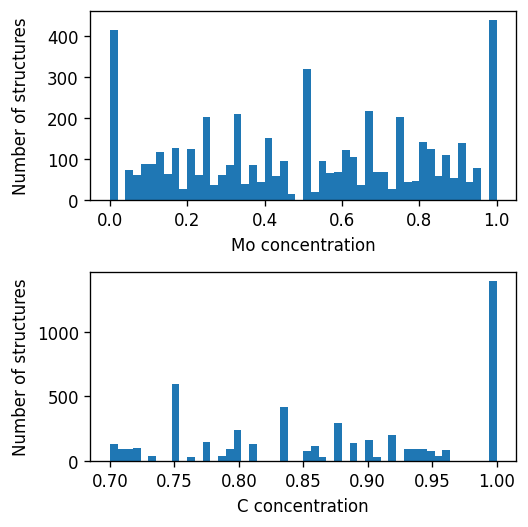Random structure generation¶
In this notebook we will generate a large pool of randomized structures.
Random here refers to a random supercell sizes with a random occupation of the Mo-V and C-vacancy sublattices.
First some helper functions are defined to make generating randomized supercells easier.
[1]:
import numpy as np
from ase.build import make_supercell
def find_sites(atoms, sym1, sym2):
"""
Find the atomic indices corresponding to, e.g., metal sites in a structure.
"""
mask_A = atoms.symbols == sym1
mask_B = atoms.symbols == sym2
mask = np.logical_or(mask_A, mask_B)
sites = np.where(mask)[0]
return sites
def generate_random_diagonal_P_matrix(n_atoms_in_prim, max_atoms, max_repeat_val):
while True:
nx = np.random.randint(1, max_repeat_val + 1)
ny = np.random.randint(1, max_repeat_val + 1)
nz = np.random.randint(1, max_repeat_val + 1)
if nx * ny * nz * n_atoms_in_prim < max_atoms:
break
return np.diag([nx, ny, nz])
def randomly_occupy_supercell(atoms):
"""
Randomly occupy a supercell with Mo-V on metal sites and
C-vacancies on carbon sites.
"""
# Find sites
metal_sites = find_sites(atoms, *metal_symbols)
carbon_sites = find_sites(atoms, 'C', 'Be')
assert len(metal_sites) + len(carbon_sites) == len(atoms)
assert len(set(metal_sites.tolist() + carbon_sites.tolist())) == len(atoms)
# Metal occupation
n_sites = len(metal_sites)
sym_A, sym_B = metal_symbols
n_A = np.random.randint(0, n_sites + 1)
n_B = n_sites - n_A
metal_occupations = [sym_A] * n_A + [sym_B] * n_B
np.random.shuffle(metal_occupations)
# Carbon occupations
n_vacancy = np.random.randint(0, int(n_sites * x_vacancy_max) + 1)
n_carbon = n_sites - n_vacancy
carbon_occupations = ['C'] * n_carbon + ['Be'] * n_vacancy
np.random.shuffle(carbon_occupations)
# occupy supercell
atoms.symbols[metal_sites] = metal_occupations
atoms.symbols[carbon_sites] = carbon_occupations
def generate_random_supercell(prim, max_atoms, max_repeat_val):
""" Generate a random (Mo, V)-(C, vacancy) supercell. """
n_atoms_in_prim = len(prim)
P = generate_random_diagonal_P_matrix(n_atoms_in_prim, max_atoms, max_repeat_val)
atoms = make_supercell(prim, P)
randomly_occupy_supercell(atoms)
atoms.wrap()
return atoms
We still need to define some parameters.
[2]:
# number of structures to generate
n_structures = 5000
# maximum number of repetitions of the primitive unit cell per direction
max_repeat_val = 10
# maximum number of atoms
max_atoms = 50
# allowed species on the metal sublattice
metal_symbols = ['Mo', 'V']
# maximum carbon vacancy concentration
x_vacancy_max = 0.3
Now we are set up to generate configurations.
[3]:
from ase.io import read
prim = read('../structures/MoC_rocksalt_prim.xyz')
n_atoms_in_prim = len(prim)
structures = []
for it in range(n_structures):
atoms = generate_random_supercell(prim, max_atoms, max_repeat_val)
structures.append(atoms)
We can generate histograms over the obtained concentrations.
[4]:
from matplotlib import pyplot as plt
fig, axes = plt.subplots(
figsize=(4.5, 4.5),
dpi=120,
nrows=2,
)
x_Mo = [atoms.symbols.count('Mo') / (atoms.symbols.count('Mo') + atoms.symbols.count('V')) for atoms in structures]
x_C = [atoms.symbols.count('C') / (atoms.symbols.count('C') + atoms.symbols.count('Be')) for atoms in structures]
ax = axes[0]
ax.hist(x_Mo, bins=50)
ax.set_xlabel('Mo concentration')
ax.set_ylabel('Number of structures')
ax = axes[1]
ax.hist(x_C, bins=50)
ax.set_xlabel('C concentration')
ax.set_ylabel('Number of structures')
fig.tight_layout()
fig.align_ylabels()
